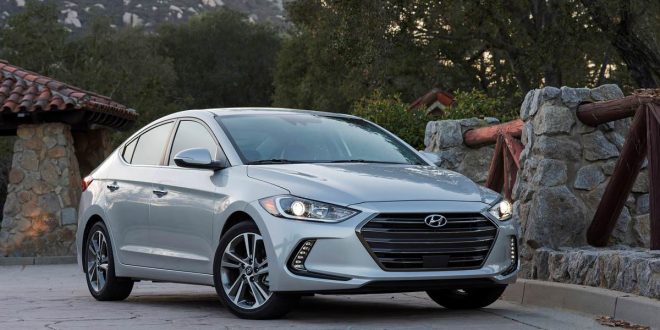We miss the brash, buzzy looks, for sure—but the 2017 Hyundai Elantra is now one of the most refined economy cars on the road.
My first impression of the 2017 Elantra was one of conflict. The car made its official debut at the 2015 LA Auto Show, and although it is more classically attractive than the 2016 version, the sixth-generation model feels a bit vanilla. Like suited-up Wall Street businessman, the Elantra is well-appointed and sharp, but its conventional aesthetic blends into the crowd. The fifth-gen model was bold and expressive in contrast, looking as if it had just crawled out of the ocean and sprouted wheels. The new body is more aerodynamic though, as its front wheel air curtains and optimized underbody give it a drag coefficient of .27, better than a Porsche 911 Turbo.
The interior follows a similar theme, because despite the fact that the materials are improved over last year (the available leather seats are particularly well-bolstered), the simpler, cleaner design is also significantly more generic. Personally, I happen to like the new layout, but you’ll be easily forgiven if you find it a bit humdrum.
While the looks of the Elantra may be a bit safe, its list of available tech features more than makes up for it. The base touchscreen has been upgraded from 4.3 inches to 7.0 inches, and navigation-equipped models get a larger 8.0-inch unit. No matter which display you opt for, Hyundai is offering Android Auto and Apple CarPlay connectivity on the Elantra for the first time, as well as an eight-speaker Infinity stereo with Clari-Fi music restoration technology. Designed to enhance the quality of digital music, Clari-Fi uses a predictive algorithm to analyze music files and “rebuild” elements that are lost during the compression process, which certainly comes in handy in the age of high-convenience, low-quality audio streaming. It may not give you studio-grade audio — the bass is a bit lacking at times — but it definitely polishes things up nicely.
The Elantra starts at just $17,150 for 2017, but my range-topping Limited model ($22,350) was spec’d out with the $2,500 Tech Package and the $1,900 Ultimate Package, bringing the final damage up to $26,750 before tacking on $835 for destination. For the money, you get everything listed above, as well as two USB ports, a power sunroof, heated leather seats front and back, a hands-free trunk, Smart Cruise Control, Lane Keep Assist, Automatic Emergency Braking with Pedestrian Assist, and Hyundai’s Blue Link Connected Car System. The Elantra also offers a generous 110.2 cubic feet of cargo volume, beating the 2016 Ford Focus and Mazda3, but falling slightly short to the Honda Civic and Toyota Corolla.
Smarter and safer
Where the Elantra impresses most is in its suite of available tech. If anything, the vehicle’s safety and convenience features are what will drive potential buyers toward Hyundai dealerships, as the car equips several nameplate and segment-first gadgets and gizmos.
The most notable of the lot is Automatic Emergency Braking with Pedestrian Detection, which you won’t find on the Civic, Corolla, Focus, Mazda3, Chevy Cruze, or Nissan Sentra. Keeping with the theme of autonomous safety systems, the sedan provides Lane Keep Assist and Smart Cruise control, however they’re not available on the base model. One thing on the adaptive cruise control though, it does not function below 6 mph, which means it’ll slow you down, but not stop you. The dashboard does send a warning before it returns braking and acceleration controls to the driver, but this seems like a large oversight by Hyundai. Why? It’s likely that the low-speed radar sensor necessary to stop the car would increase the vehicle’s base price.
Hyundai’s Blue Link system is also featured on the Elantra for the first time, which allows owners to remotely start their vehicle, operate the door locks, find their vehicle with mobile devices, and use Google’s destination search function. Blue Link is compatible with wearable devices like Apple Watch and Android Wear as well, and also provides roadside assistance and stolen vehicle recovery.
Agencies/Canadajournal
 Canada Journal – News of the World Articles and videos to bring you the biggest Canadian news stories from across the country every day
Canada Journal – News of the World Articles and videos to bring you the biggest Canadian news stories from across the country every day



